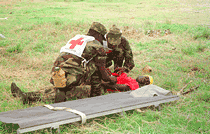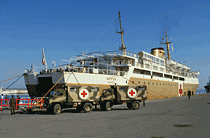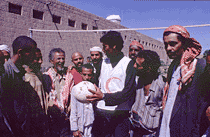In 1864 an international
conference wrote the First Geneva Convention, which was improved upon in
later conferences, culminating in the four Geneva Conventions of 1949 -
the Geneva Conventions as we now know them.
|
GENEVA CONVENTION
I
|
|
|
|
|
GENEVA
CONVENTION I which protects wounded and sick members of the armed
forces in the field, and medical and religious personnel attached to the
armed forces. |
 |
|
Essentially:
When combatants come across
wounded enemy soldiers in the field, they should collect them, care for
them, hand them over to a superior or to the nearest medical personnel,
and respect medical personnel and facilities. |
|
|
|
|
|
|
|
GENEVA CONVENTION
II
|
|
|
|
|
GENEVA
CONVENTION II which protects wounded, sick and shipwrecked members
of the armed forces at sea, and medical and religious personnel. |
 |
|
Essentially:
When combatants come across
wounded and shipwrecked enemies at sea they should protect them (including
aircrews), search for them and collect them after every engagement, protect
civilian boats rescuing the wounded and shipwrecked, and respect hospital
ships and medical aircraft marked with a Red Cross or Red Crescent. |
|
|
|
|
|
|
|
GENEVA CONVENTION
III
|
|
|
|
|
GENEVA
CONVENTION III which protects prisoners of war. |
 |
|
Essentially:
When combatants take prisoners
of war they should spare them, disarm them, hand them over to a superior,
treat them humanely, and inform their families of their capture. |
|
|
|
|
|
|
|
GENEVA CONVENTION
IV
|
|
GENEVA
CONVENTION IV which protects civilians in enemy territory or in
a country under occupation. |
 |
|
Essentially:
When combatants encounter
civilians they should respect them, treat them humanely, and protect them
against ill-treatment. Vengeance and hostage-taking are forbidden, and
their property must be respected, not damaged or stolen. |
|
|
|
| While
the Geneva Conventions regulate international wars between two or more
nations, it was not until 1977 that internal wars were comprehensively
addressed by the international community. Until then, wars of "liberation"
and civil wars were governed largely by the "goodwill" of the warning parties.
But goodwill was not always present, especially in dealing with prisoners
and civilians, during many wars of liberation in the years following the
Second World War. So in 1977 the two Additional
Protocols were created to complement and further widen the scope of
IHL. |
|